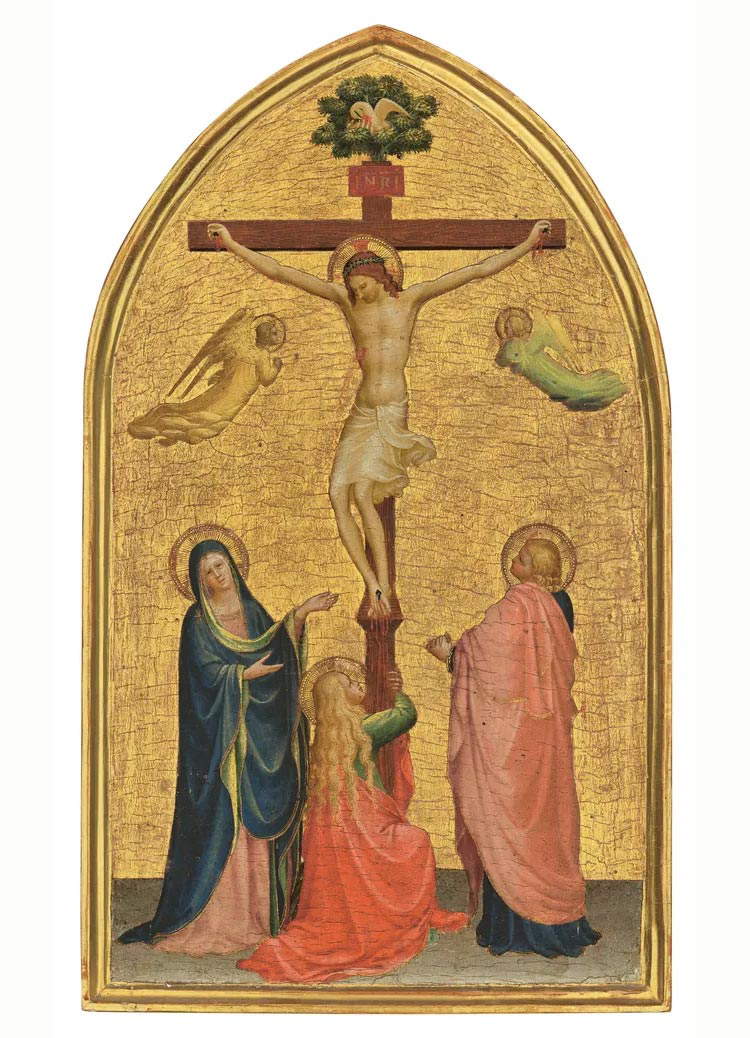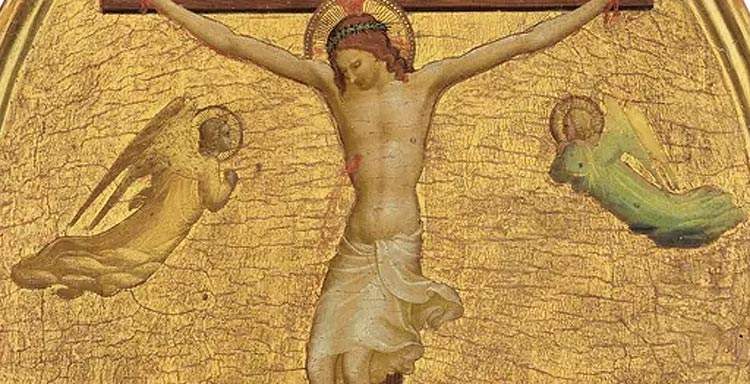The youthful Crucifixion by Beato Angelico (Giovanni da Fiesole, born Guido di Pietro; Vicchio, c. 1395 - Rome, 1455), a splendid work by the artist bridging the Gothic and Renaissance periods that had reappeared on the market in June 2023, has been purchased by theAshmolean Museum in Oxford: the British museum announced the deal today. The deal cost 4.48 million pounds (5.38 million euros), and the sum was raised through grants and donations.
Beato Angelico’s masterpiece, which has been in the UK for nearly two centuries, had been sold in July 2023 to a foreign buyer (for the sum of £5 million, or 5.8 million euros) and was in danger of leaving the country. Because of the value and importance of the work to the nation, the Review Committee on Exports of Art and Objects of Cultural Interest, supported by the Arts Council, at the end of the year recommended to the Secretary of State for Culture, Media and Sports that the export license on the work be temporarily suspended. Thus, in January 2024, a temporary freeze on the work’s export was announced to allow, under English law, an interested public entity to bid to purchase the work. The temporary freeze then gave the Ashmolean nine months to express interest in acquiring the work and raise the funds needed to keep the painting in the UK. The first deadline was April 7, three months after the start of the blockade: after this period ended, owners of the work had fifteen days to consider offers to purchase it above the recommended price (set at £5,001,000 plus VAT). After this period had passed, the law provided for an additional six-month interval to allow private negotiations to begin.
And it was a sale by private negotiation that enabled the Ashmolean to acquire the work for £4.48 million, a substantial reduction in its market price. Indeed, British law allows the Secretary of State to consider offers below the recommended price if they come through the private treaty sale procedure. Now acquired, the painting will be on public display for the benefit of visitors, students, scholars and enthusiasts.
Beato Angelico is one of the most important artists of the Renaissance. His paintings are characterized by compelling naturalism and the distinctive color palette of blue, pink-red and gold. Painted around 1420, the Crucifixion is one of Beato Angelico’s earliest works and testifies to the power, beauty, and sensitivity for which he would later become known. An “absolute and unquestionable masterpiece of Fra Angelico’s early phase, yet not belonging to the small nucleus of his debut works,” according to Angelo Tartuferi, one of Beato Angelico’s leading experts.
Most of Fra Angelico’s paintings are large frescoes or monumental altarpieces that remain in situ in Dominican churches and convents in and around his hometown of Florence and in the Vatican. This painting, in contrast, is one of the artist’s few surviving small-scale works on panel . It is able to offer a relevant insight into both Beato Angelico’s innovative painting style and the development of European painting more generally.
There are currently very few paintings by Beato Angelico in British public collections, a fact noted by the Review Committee when it considered its recommendation. Outside London, only the Ashmolean is fortunate enough to hold a work by the master and his workshop in its collection. This work, a triptych depicting the Virgin and Child with angels and a Dominican saint flanked by Saints Peter and Paul, is currently on display in the museum’s gallery of ancient Italian art. The Crucifixion will soon be exhibited alongside the later work, allowing visitors to appreciate how the artist’s style developed over the course of his career, and the extent to which his delicate and emotive approach was already well established by the 1520s.
The Crucifixion will join the Ashmolean’s important collection of Italian Renaissance artworks, which includes paintings by Paolo Uccello and Titian and important drawings by Raphael and Michelangelo. The acquisition of the Crucifixion further expands this preeminent collection and will inspire a total refurbishment of the museum’s galleries devoted to the Italian Renaissance, which have not been on display since 2009. The acquisition of the Crucifixion underscores the Ashmolean’s role as an important center for the study of Italian Renaissance art. What’s more, the Crucifixion will also serve as a teaching resource for the University of Oxford, where it will be of particular interest not only to the departments of Art History and History, but also to the Department of Theology and Religion and Blackfriars Hall, the Dominican community founded in 1221 located next to the Ashmolean.

Here is a list of those who helped raise the sum: Lord Lupton, National Heritage Memorial Fund, David and Molly Lowell Borthwick, Art Fund, Headley Trust, Emmett Family, Barrie and Deedee Wigmore, John Booth, Dr Anthea Hume, Patrons of the Ashmolean Museum, Lord and Lady Sassoon, Ian and Caroline Laing, Mrs Rosamond Brown, Henry Oldfield Trust, Christian Levett, Chris Rokos, Fernside Trust, Denys and Victoria Firth, Ruddock Foundation for the Arts, Daniel Katz Gallery, Lady Heseltine, Gillian Berg, Catherine Lewis Foundation, Eddie Dinshaw Foundation, Fabrizio Moretti, Park Charitable Trust, Rockcliffe Charitable Trust, Society of Amateurs Charitable Trust, Omnia Art Ltd., Nicholas Barber, David & Lexi Young Charitable Trust, Lord Faringdon Charitable Trust, Michael & Sue Pragnell, Francis Russell, Sir Martin Smith & Lady Smith, Cristina & Nicholas White, John & Margaret Leighfield, Dame Helen Ghosh, Sir David Scholey, The British Italian Society, Mr & Mrs Leckie, Sue & Sandy Arbuthnot, Dr Harry Dickinson, Dame Pippa Harris, Miss Elizabeth Howe OPL, Teresa Krasny, Richard Mayou, Christopher North and Sophie de Brito and Cunha-North, Mr and Mrs Michael Pelham, Adrian Sassoon, Edward Smyth, Mark Stevenson and those who wish to remain anonymous along with many others. They are joined by the Art Fund, which supported the museum in closing the campaign in its final days.
Lord Lupton, chairman of the Ashmolean Museum’s Board of Visitors, says, “This acquisition represents a collective outpouring of support from so many generous donors and individuals, aligned in their desire that such an important Renaissance painting be shared with the widest possible audience. I am delighted that the Ashmolean Board has played such an important role in the campaign, and I look forward to experiencing the joy and wonder that the painting will inspire.”
Director Xa Sturgis emphasizes, "Beato Angelico’s Crucifixion is a wonderful acquisition for the Ashmolean, transforming our premier Renaissance collection. I am thrilled that millions of visitors who walk through our doors will now be able to view this beautiful, moving and important work, the artist’s first surviving painting on a subject to which he would return again and again throughout his career. Raising nearly 4.5 million pounds in just six months was no easy task in the current climate, and I am immensely grateful to old and new friends who helped us cross the finish line in just a few days."
Professor Jennifer Sliwka, head of the Western Art Department at the Ashmolean Museum, explains, "Fra Angelico was recognized as having a rare and perfect talent by the famous artist-biographer Giorgio Vasari in the 16th century, and his work was later praised by the great Victorian artist and author John Ruskin, who described it as ’closer to heaven than any human hand or mind could ever reach.’ I am thrilled that Beato Angelico’s Crucifixion will become public property for the first time, allowing visitors to the Ashmolean to experience firsthand its painterly skills and its ability to evoke deep emotional and psychological states. The idea that this groundbreaking and wonderful work by one of the greatest painters of the Italian Renaissance will continue to inspire and excite visitors to the museum for centuries to come fills me with joy, and I am immensely grateful to the funding bodies and people who have made this possible for the benefit of us all."
Andrew Hochhauser, Chair of the Review Committee, says, “The Review Committee is delighted that the Ashmolean is welcoming this extraordinary work into its public collection, ensuring that it will inspire and educate people from across the country for generations to come. This acquisition represents our commitment to preserving our national treasures and enriching the cultural fabric of our communities.”
Simon Thurley, chairman of the National Heritage Memorial Fund, says, "Beato Angelico’s masterpiece, the Crucifixion, having long been in private ownership, is in remarkably good condition and is a rare and worthy addition to the Ashmolean’s important collection of Renaissance art. The National Heritage Memorial Fund exists to create an extraordinary collection of the United Kingdom’s finest heritage as a permanent memorial to those who have given their lives for the United Kingdom. We are delighted that the Crucifixion is now part of this incredible collection accessible to the public."
Jenny Waldman, director of the Art Fund, says, “Very few paintings by Beato Angelico, one of the great painters of the Italian Renaissance, are preserved in UK collections. I am thrilled that, with the generosity of our supporters and National Art Pass members, the Art Fund has been able to help the Ashmolean Museum acquire this extraordinary addition to its collection, where it will be on public display for the first time in this country. I am confident that the painting will capture the attention of visitors and inspire scholars for many years to come.”
 |
| Oxford's Ashmolean Museum acquires a masterpiece by Beato Angelico |
Warning: the translation into English of the original Italian article was created using automatic tools. We undertake to review all articles, but we do not guarantee the total absence of inaccuracies in the translation due to the program. You can find the original by clicking on the ITA button. If you find any mistake,please contact us.